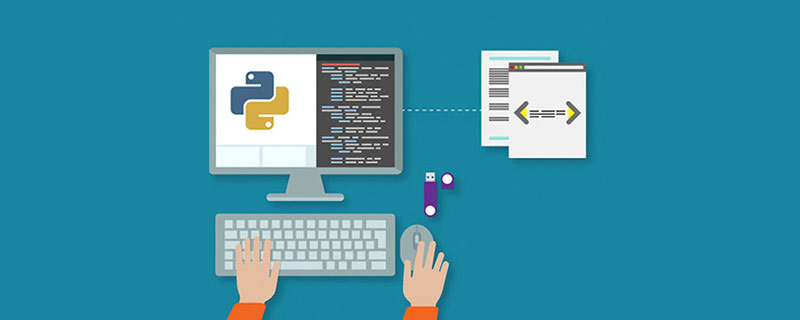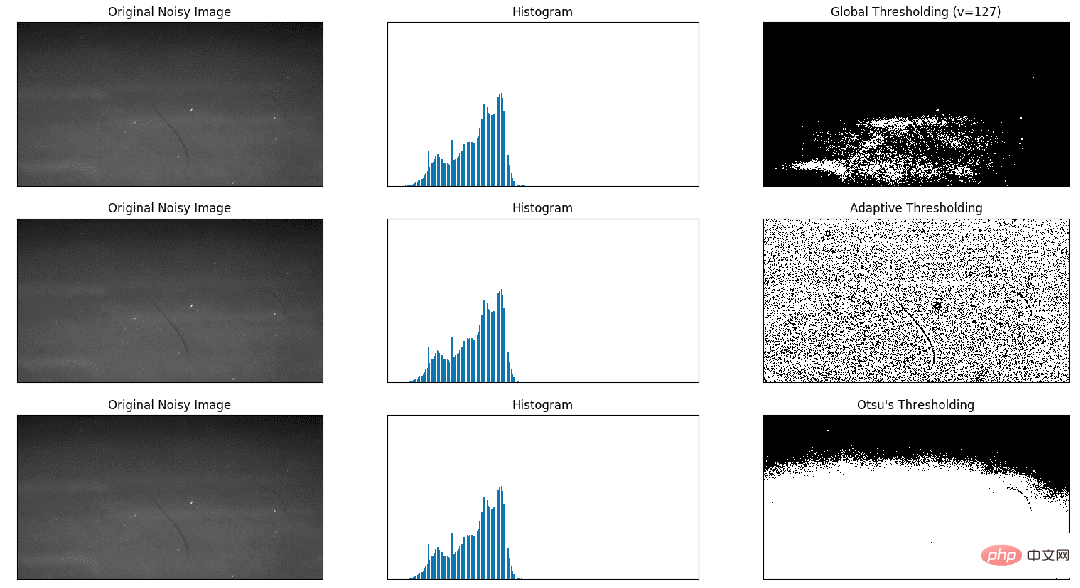Heim >Backend-Entwicklung >Python-Tutorial >Eine Sammlung von Beispielen für Binarisierungsmethoden für die Python-Bildverarbeitung
Eine Sammlung von Beispielen für Binarisierungsmethoden für die Python-Bildverarbeitung
- coldplay.xixinach vorne
- 2020-07-27 17:10:502859Durchsuche

Bei der Verwendung von Python für die Bildverarbeitung ist die Binarisierung ein sehr wichtiger Schritt. Jetzt habe ich 6 Bildbinarisierungsmethoden zusammengefasst, auf die ich gestoßen bin (natürlich ist dies definitiv nicht der Fall). Alle Binarisierungsmethoden werden fortgesetzt hinzugefügt werden, wenn neue Methoden entdeckt werden).
Verwandte Lernempfehlungen: Python-Video-Tutorial
1. opencv einfacher Schwellenwert cv2.threshold
2 cv2.adaptiveThreshold (Es gibt zwei Methoden zur Berechnung von Schwellenwerten in adaptiven Schwellenwerten: mean_c und guassian_c. Sie können versuchen, welche besser ist)
Otsus Binarisierung
Beispiel:
import cv2 import numpy as np from matplotlib import pyplot as plt img = cv2.imread('scratch.png', 0) # global thresholding ret1, th1 = cv2.threshold(img, 127, 255, cv2.THRESH_BINARY) # Otsu's thresholding th2 = cv2.adaptiveThreshold(img, 255, cv2.ADAPTIVE_THRESH_MEAN_C, cv2.THRESH_BINARY, 11, 2) # Otsu's thresholding # 阈值一定要设为 0 ! ret3, th3 = cv2.threshold(img, 0, 255, cv2.THRESH_BINARY + cv2.THRESH_OTSU) # plot all the images and their histograms images = [img, 0, th1, img, 0, th2, img, 0, th3] titles = [ 'Original Noisy Image', 'Histogram', 'Global Thresholding (v=127)', 'Original Noisy Image', 'Histogram', "Adaptive Thresholding", 'Original Noisy Image', 'Histogram', "Otsu's Thresholding" ] # 这里使用了 pyplot 中画直方图的方法, plt.hist, 要注意的是它的参数是一维数组 # 所以这里使用了( numpy ) ravel 方法,将多维数组转换成一维,也可以使用 flatten 方法 # ndarray.flat 1-D iterator over an array. # ndarray.flatten 1-D array copy of the elements of an array in row-major order. for i in range(3): plt.subplot(3, 3, i * 3 + 1), plt.imshow(images[i * 3], 'gray') plt.title(titles[i * 3]), plt.xticks([]), plt.yticks([]) plt.subplot(3, 3, i * 3 + 2), plt.hist(images[i * 3].ravel(), 256) plt.title(titles[i * 3 + 1]), plt.xticks([]), plt.yticks([]) plt.subplot(3, 3, i * 3 + 3), plt.imshow(images[i * 3 + 2], 'gray') plt.title(titles[i * 3 + 2]), plt.xticks([]), plt.yticks([]) plt.show()
Ergebnisbild:

4. Skimage-Niblack-Schwellenwert
5. Skimage-Sauvola-Schwellenwert (wird hauptsächlich zur Texterkennung verwendet)
Beispiel:
https://scikit-image.org/docs/dev/auto_examples/segmentation/plot_niblack_sauvola.html
import matplotlib
import matplotlib.pyplot as plt
from skimage.data import page
from skimage.filters import (threshold_otsu, threshold_niblack,
threshold_sauvola)
matplotlib.rcParams['font.size'] = 9
image = page()
binary_global = image > threshold_otsu(image)
window_size = 25
thresh_niblack = threshold_niblack(image, window_size=window_size, k=0.8)
thresh_sauvola = threshold_sauvola(image, window_size=window_size)
binary_niblack = image > thresh_niblack
binary_sauvola = image > thresh_sauvola
plt.figure(figsize=(8, 7))
plt.subplot(2, 2, 1)
plt.imshow(image, cmap=plt.cm.gray)
plt.title('Original')
plt.axis('off')
plt.subplot(2, 2, 2)
plt.title('Global Threshold')
plt.imshow(binary_global, cmap=plt.cm.gray)
plt.axis('off')
plt.subplot(2, 2, 3)
plt.imshow(binary_niblack, cmap=plt.cm.gray)
plt.title('Niblack Threshold')
plt.axis('off')
plt.subplot(2, 2, 4)
plt.imshow(binary_sauvola, cmap=plt.cm.gray)
plt.title('Sauvola Threshold')
plt.axis('off')
plt.show()Ergebnisdiagramm:

6.IntegralThreshold (wird hauptsächlich zur Texterkennung verwendet)
Verwendung: Führen Sie die Datei util.py unter der folgenden URL aus:
https:/ /github.com /Liang-yc/IntegralThreshold
Ergebnisdiagramm:

Das obige ist der detaillierte Inhalt vonEine Sammlung von Beispielen für Binarisierungsmethoden für die Python-Bildverarbeitung. Für weitere Informationen folgen Sie bitte anderen verwandten Artikeln auf der PHP chinesischen Website!

